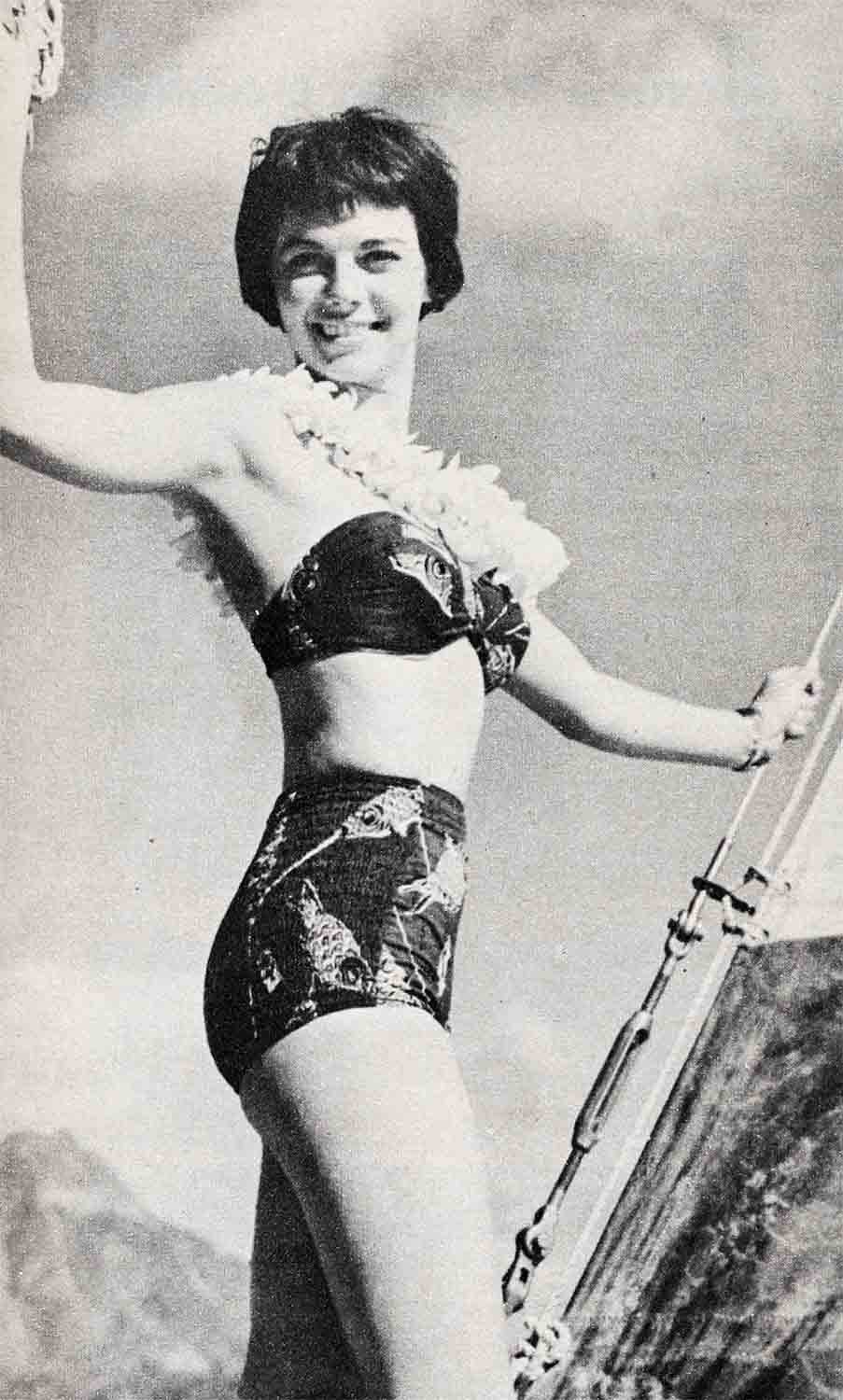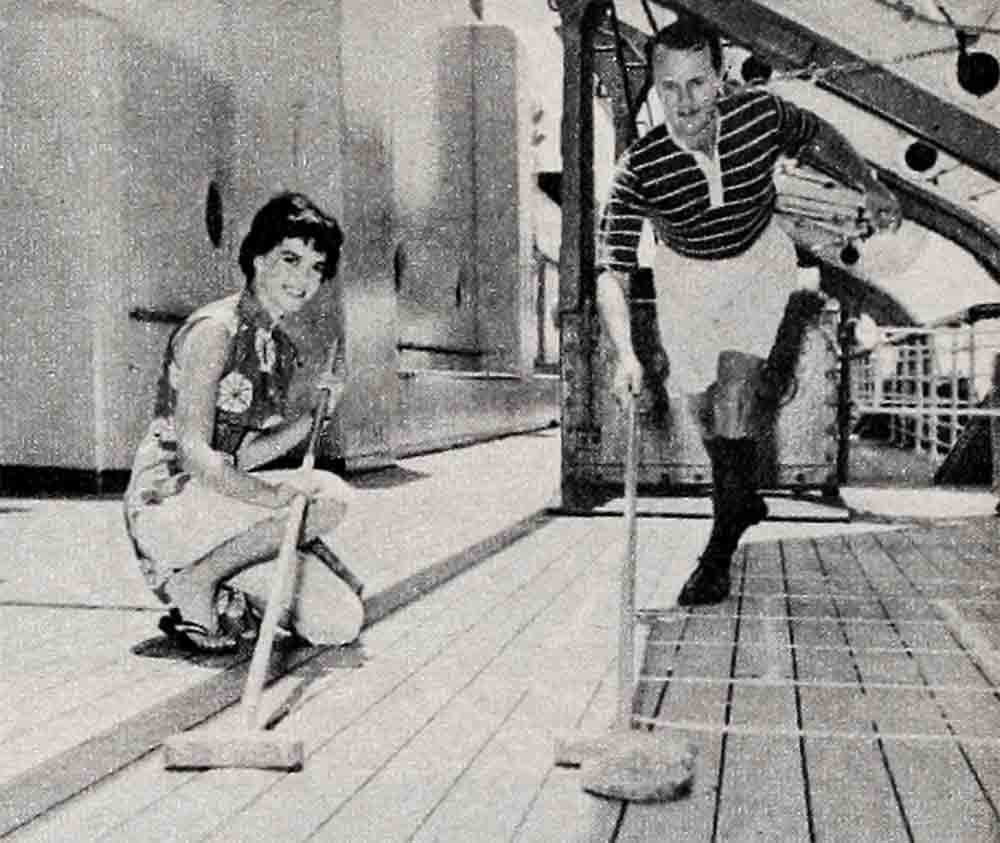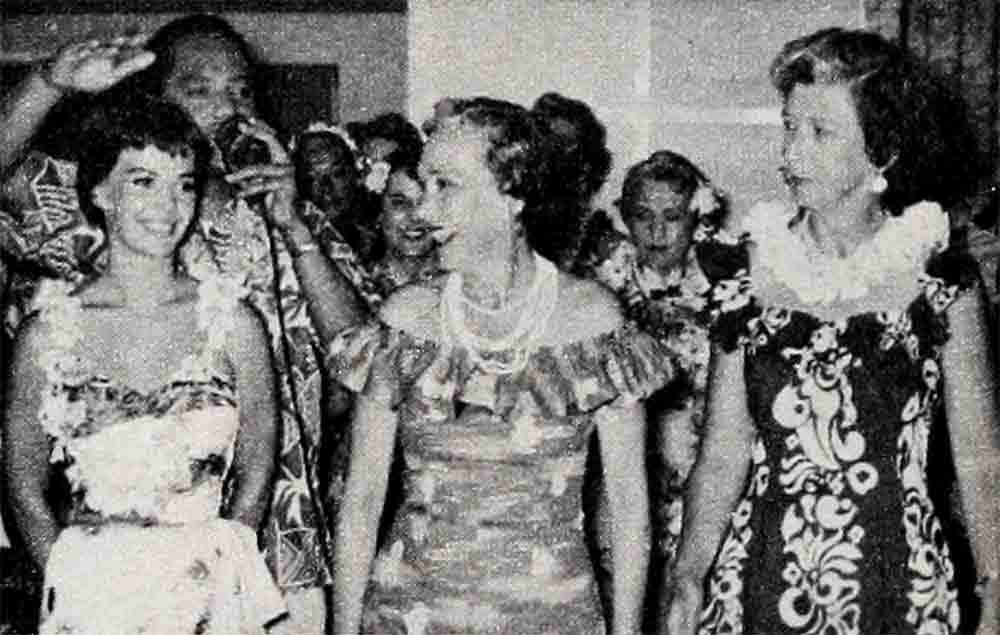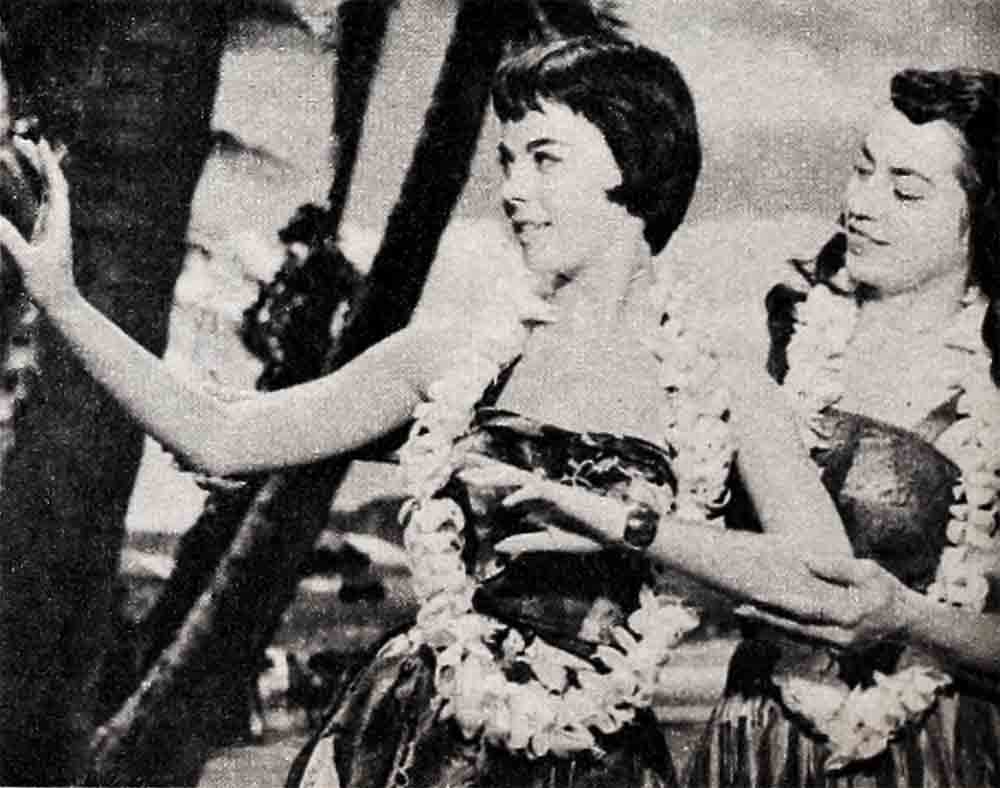Aloha Means Goodbye—By Natalie Wood

Maybe it was because everybody had spring fever, or maybe it was because I had been a good girl and made five pictures in a row without a single day off. Anyhow, my studio, Warner Brothers, decided last spring that I should have a vacation.
I was ecstatic. Two whole weeks off! You can do a lot in two weeks. And I had never been anywhere—anywhere out of the country, that is. So Mother and I read foreign-travel folders voraciously. Finally, we decided on Hawaii.
AUDIO BOOK
No sooner had we decided, it seemed, than we were on our way. I finished my work in “The Burning Hills” on a Friday night, and by early Saturday morning Mother and I were on a transpacific airliner on our way to the romantic, magic islands of Hawaii.
There wasn’t anything very romantic about our departure. My father took us to the plane and waved us off. Then Mother and I settled down to read. Nobody on the plane paid any attention to me—maybe because I looked so studious. I was reading Thus Spake Zarathustra, by Nietzsche. I had brought along a lot of other books, several on psychology by Carl Jung; Band of Angels, by Robert Penn Warren; Thames Williamsons’ Woods Colt; and even The First Six Lessons in Acting, by Boleslavsky, which Scott Marlowe had given me as a going- away present. But, early as it was, and tired as I was, I was just in the mood for Nietzsche.

The time difference between Hawaii and the mainland makes the flight seem wonderfully short. Miraculously soon the sky was pink from the setting sun and we were coming down at Honolulu.
Hawaiian dancers greeted us, and bedecked us with our first leis, made of ginger blossoms. We felt strange and wonderful, since we had left home such a short time ago. Not so strange, however, were the photographers who took our pictures. (On Warner Brothers Pictures, like the British Empire, it seems, the sun never sets.)
We had a little car, a Yellow Hornet, waiting for us, and we drove to The Reef, the hotel we had chosen because the travel folders said it was the most informal.
Our room opened on to a lovely terrace overlooking a beautiful garden. We had our dinner there, watched the dancing, and listened to the singing from down below. We loved it, but at the same time we felt out of it—we were homesick already!
We left our coffee cooling in the cups and placed two phone calls. Mother talked to my father and told him how much she missed him, and I called Scott Marlowe, whom I’ve been seeing quite a lot, and told him the same thing.
For the first few days, that homesick feeling lingered. We did all the standard things—toured the island and admired the Pali, saw Hanaua Bay, and the Blow Hole. We walked a lot, which became quite a chore because I was wearing too-warm clothes and high-heeled shoes. It was my first—and I expect my last—experience as a sight-seeing tourist. Everywhere we went we were given flowers, beautiful, fragrant leis. We also bought the traditional cocoanut hats and had our pictures taken in them.

Because a student from the University of Hawaii, Dentler Erdman, was helping the studio photographer, we visited the campus during lunch time and talked with the students. They had all seen “Rebel Without a Cause,” and they’d all loved it. Of course, they wanted to know all about Jimmy Dean.
From there we went to a Japanese tea-house, where we sat on the floor with our shoes off, wore kimonos and toyed with the strange, exotic food.
After all our touring about, I was tired and a little letdown.
“All I really wanted to do,” I told Mother that night, “was rest, and read, and lie in the sun.” And, I added, “I guess I’m not so much a sight-seer as a people-knower.”
Mother laughed and said, “From now on we’ll rest. If the photographers want any more pictures of you, they can come to the beach to get them.”
The next morning I got my first chance to wear my new bathing suit and my first chance to lie on the beautiful white beach.
I expected to be alone on the beach. I didn’t know anybody at the hotel except Cathy Crosby, and she couldn’t go out in the sun because she sunburns terribly. So I took my beach towel and a pile of books and prepared to spend the day in splendid solitude. That was at about ten o’clock. An hour later, I was straddling a pontoon of one of the catamarans, riding the waves. At one o’clock, I was having lunch on the beach with a dozen or so beach boys. At three, I was on a surfboard heading out to sea and admiring the coral reefs so clearly visible on the ocean bottom. An hour later, someone was saving me—as a matter of fact, four or five boys were saving me. That ocean bottom was deceptive. I was out in very deep water and had never ridden a surfboard in my life. But even being saved was fun.

This was definitely more like it!
Some of the people I met that afternoon urged Mother and me to abandon our hotel room terrace and have dinner with them at a restaurant they all raved about, The Queen’s Surf.
We agreed, but I told them Id have to go shopping first. Somebody back home had told me it would be cold in Hawaii in the spring and I had brought all the wrong clothes.
Late the next afternoon, I tore myself away from the beach and drove to the Royal Hawaiian, where I had been told the best dress shops were.
I walked into the lobby only to be told, politely but firmly, that I would have to leave. I was wearing shorts. When I explained that I had come to shop they let me duck into Pauline Lake’s and then into Betty Higgins’ where—this is for the girls—I went stark raving mad and bought everything!
I had never seen such beautiful clothes. I bought tea-timers, and muu-muus, and robes and sarongs, particularly a Tiger sarong. (This in honor of my friend, Nick Adams, who calls me Tiger.) I went too-too sophisticated and bought a black sari and a wonderful Indian stole, handwoven with fabulous gold and silver threads.
Then I was ready for The Queen’s Surf.
Mother and I went there that evening. I will never forget that night because of two new friends I met there.
The Queen’s Surf is a beautiful place, set in a grove of palm trees. The dinner was exquisite and the entertainment . . . that’s where my new friends came in.
When the first floor show began I saw them. One was Mahi Beamer, an Hawaiian boy, descendant of the oldest pure- Hawaiian family in Honolulu. Mahi sings in a high, clear voice—almost soprano—all the songs which have become identified with the island. His closing number is always “My Island Love Song.” He sings it beautifully, and he should—his grandmother wrote it.

Co-starred with Mahi was a dancer, Lei Aloha Cunningham, who is also Hawaiian. (The Cunningham was contributed by an American husband from whom she has been divorced.) I had seen hula dancers before, not only in Hawaii, but at home—but I had never seen anything like Lei Aloha, so graceful, dignified, and regal.
As an old people-knower, I decided that these were people I very much wanted to know. I wrote a note, inviting them to our table, and asked the waiter to take it to them. They came over, looking very dignified, almost aloof.
They must decline my invitation, they told me, since they had two more shows to do. Mother and I stayed through both of them. It was wonderful, but I felt disappointed. I really wanted to know them.
Two days later, I had my chance. I was walking on the beach with one of the college boys I had met, and we ran into Mahi and Lei Aloha.
Mahi put out his hand and smiled very warmly. He’s twenty-five, but looks about eighteen, and is very handsome and very charming.
“We’re preparing for a luau tonight,” he told us. “Won’t you join us?”
We did, of course, and went with them to the restaurant. After the preparations for the feast were complete, we gathered around the piano and sang all the wonderful, romantic songs of the islands. It was a perfect preparation for my first luau.
Mother and I went to The Queen’s Surf early that night and sat on the floor beside the festive tables. We ate everything. To our amazement, we discovered that we loved the poi and the raw salmon—all the Hawaiian food. (Probably because we now had Hawaiian friends.)
Again Mahi and Lei Aloha did three shows that night, and again we stayed to see all of them. After that, I spent every night at The Queen’s Surf and each night, after the last show, I went with Mahi and Lei Aloha to all sorts of truly Hawaiian, out-of-the-way places that very few tourists are fortunate enough to see.
From then on the time, which had dragged at first, simply flew. There just weren’t enough hours left to do all the things we wanted to do.
All too soon, the morning dawned when Mother and I had to board the SS Lurline and sail for home. It was a thrilling leave-taking, and somewhat sad—which was rather ironic. When we’d first arrived we’d been homesick—now we were sad to be leaving!
Everybody came to see us off—all the kids I had met at the University, all the boys I had swum with and surfed and sailed with and, most importantly, Mahi and Lei Aloha. Mahi sang and Lei danced, and all the people—even many we didn’t even know—kissed us goodbye and piled us up to our eyes in leis. It was all unforgettable, but most of all, I will remember Mahi and Lei; they will always be two of my closest and dearest friends.
Finally, Mother and I made our way to the gangplank and aboard the ship. Everybody on shore was waving and crying, and so were we. Standing at the rail, we waved and cried some more. The band played and we waved and cried. The ship’s whistles blared, and we waved and cried again. Slowly the big liner eased out into the channel. Still waving and crying, I started throwing my leis into the water, watching as the beach boys came swimming out to get them. When we couldn’t see them any more, I went to our stateroom, collapsed on the bed—and cried some more.
After all the excitement of our last few days on the island and the colorful sendoff, the crossing seemed rather uneventful, although there was plenty to do—more swimming and sunning, shuffleboard, miniature horse races (Mother was luckier at betting than I was). Part of the time the weather was unfriendly; then we kept pretty much to our stateroom or relaxed in our deck chairs. (Some sailors we weren’t!)
One night, there was an Hawaiian party. I wore my new Tiger sarong and won first prize. One day I took a try at trap shooting from the bow of the ship. For this no prizes, but a stiff shoulder.
Mostly, for the five days I rested, and read—no Nietzsche now, but romantic things like Sayonara. Much of the time I just sat and remembered the beauty of the islands, and the warm hospitality of my new friends.
After we docked in San Francisco, we spent two days with my married sister, Teddy, and her family. We showed them all our pictures and told all our tall tales. Then we flew on to Los Angeles, where my father and Scott Marlowe met us at the airport.
Seeing their handsome, welcoming faces reminded us: We had been homesick in Hawaii—at first. Now, although it was wonderful to be back, I was already homesick for Hawaii!
THE END
It is a quote. PHOTOPLAY MAGAZINE SEPTEMBER 1956
AUDIO BOOK




